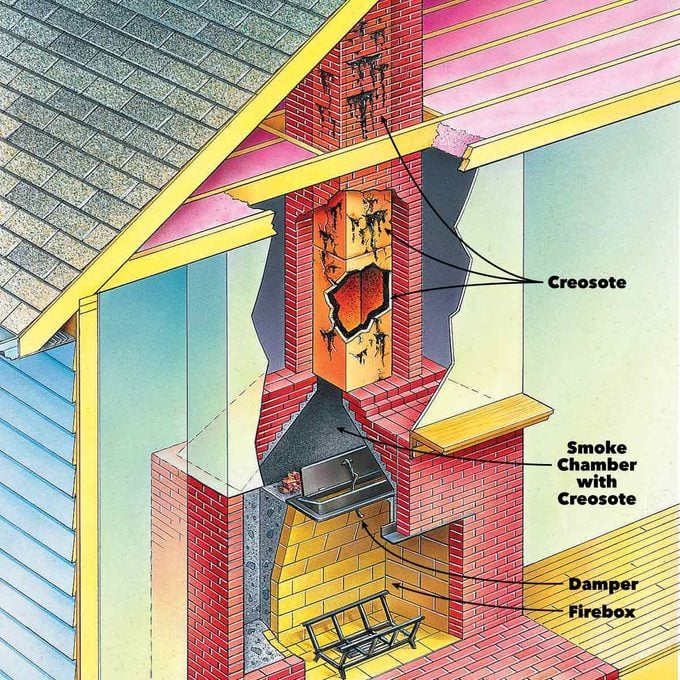Chimney Cleaning: When to Clean a Chimney Flue
Updated: Oct. 01, 2023
How often to remove creosote to prevent chimney fires and do a fireplace cleaning.
How Often Should You Clean Your Chimney?
There isn’t one set rule on how often a chimney should be cleaned. But it’s still an important part of any fire safety routine. A smoky fire without enough oxygen emits lots of unburned tar vapors called “creosote” which can possibly lead to a chimney fire. The good news, though, is that you can reduce creosote buildup in your fireplace flue by making sure the airflow to your fire is adequate, which will generate a hot, clean-burning fire.
What Is Creosote?
Creosote is a substance created when there isn’t quite enough airflow into your fireplace. Inadequate airflow starves the fire, which means that some of the oils in the wood are not entirely burned. What’s left of the oil travels up the chimney with the rising smoke. As the smoke rises, it cools, leaving behind a residual mixture of smoke, water and other chemicals on the interior of the chimney. That residue is creosote.
How to Check for Creosote
The first thing to do when checking for creosote is to make sure there’s no downdraft from the chimney. If you do feel any downward airflow, open a door or window on the same floor as the fireplace. Keep monitoring the airflow until the downdraft stops or reverses. If you’re having trouble telling which way the air is flowing, tape tissue to the fireplace opening and watch its movement.
While wearing goggles and a basic disposable dust mask, take a flashlight and a fireplace poker and scratch the black surface above the fireplace’s damper (smoke chamber). If the groove you scratch in the creosote is paper thin. If it’s 1/8-in. thick, schedule a fireplace cleaning soon. If you have 1/4-in. of creosote or more, do not use the fireplace again until it is cleaned—a chimney fire could occur at any time.
The easiest creosote to remove is the feather-light dull gray, brown or black soot. The next form is a black granular accumulation, removed fairly easily with a stiff chimney brush. The third type of creosote is a road tar-like coating that is much harder to remove even with stiff chimney brushes, scrapers or power rotary whips. The final (and most problematic) is a shiny, glaze-like coating on the fireplace flue that is virtually impossible to remove.
Required Tools for Cleaning a Chimney
Have the necessary tools for this chimney cleaning DIY project lined up before you start—you’ll save time and frustration.
- Dust mask
- Flashlight
- Safety glasses
How to Remove Creosote
You could try to remove creosote yourself, but for a thorough job, call a chimney sweep certified by the Chimney Safety Institute of America. Make sure the sweep you hire does more than push a brush. A chimney sweep needs to be knowledgeable about building codes, trained to recognize deterioration or venting problems and able to advise you regarding the chimney’s condition. The National Fire Protection Association recommends that chimneys, fireplaces and vents be inspected at least once per year.
Another, idea to try out when it’s time to clean your chimney is a chimney sweep log. A fireplace cleaning log helps to prevent chimney fires and they help remove debris deposited along the chimney walls. These sticky deposits are called creosote. Creosote deposited over a long period becomes highly flammable and it’s often the cause of chimney fires. Creosote removal is vital to your safety. Sweeping logs are popular because of their ease of use for creosote removal. All you have to do is unwrap the log from its package and place it in a lit wood-burning fireplace.
